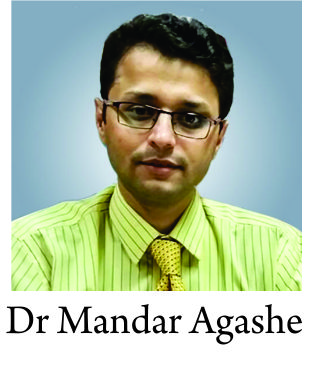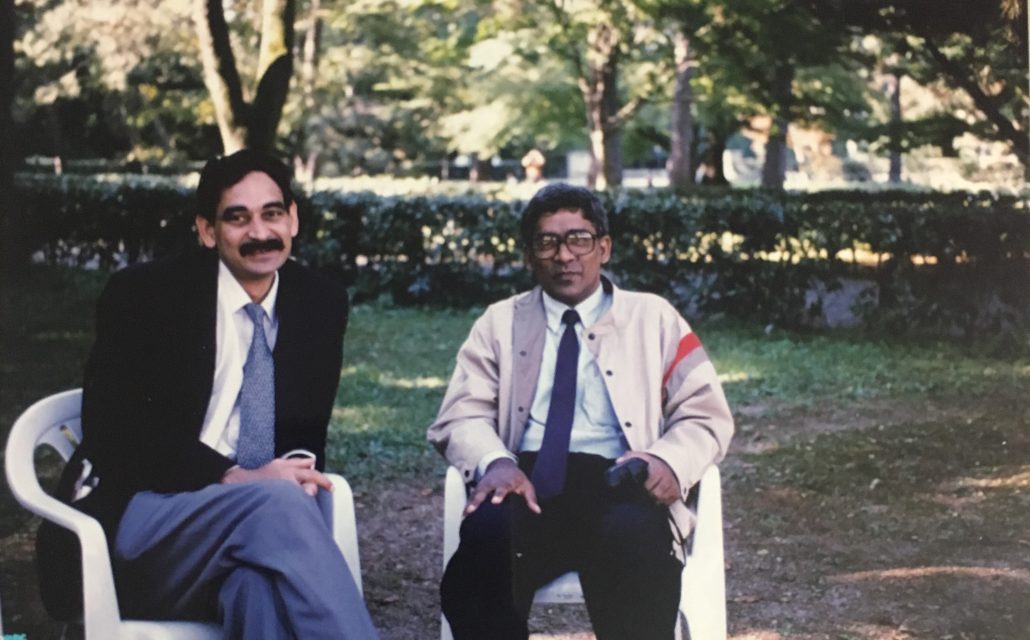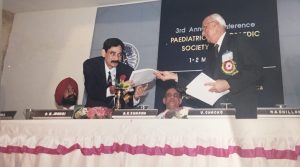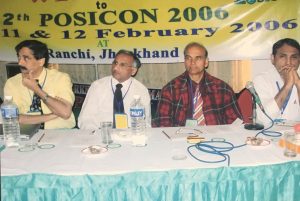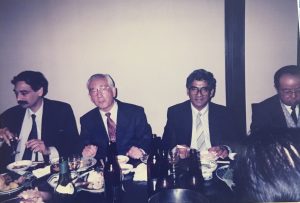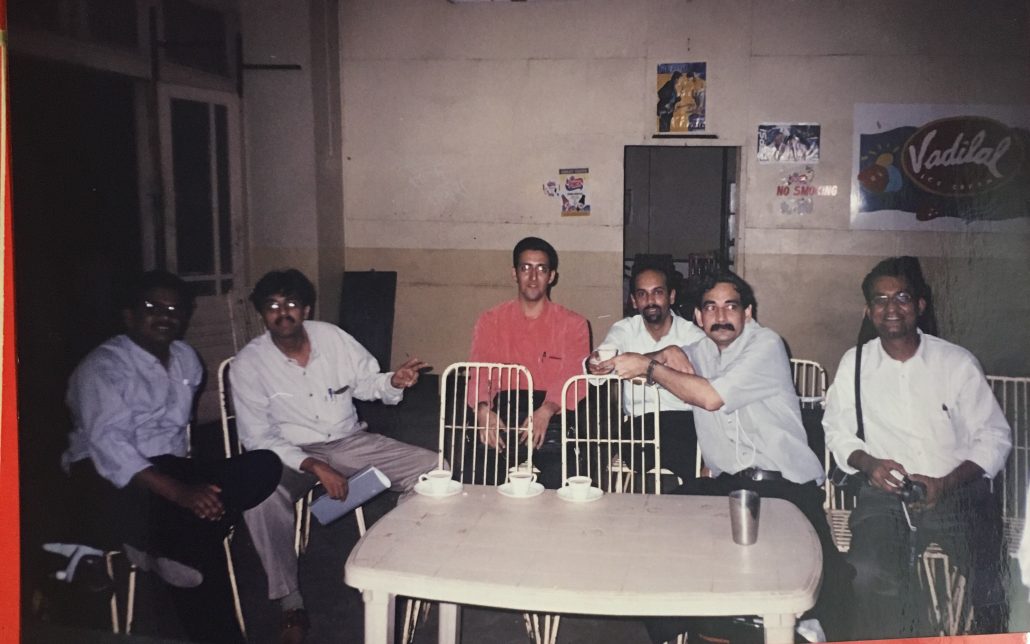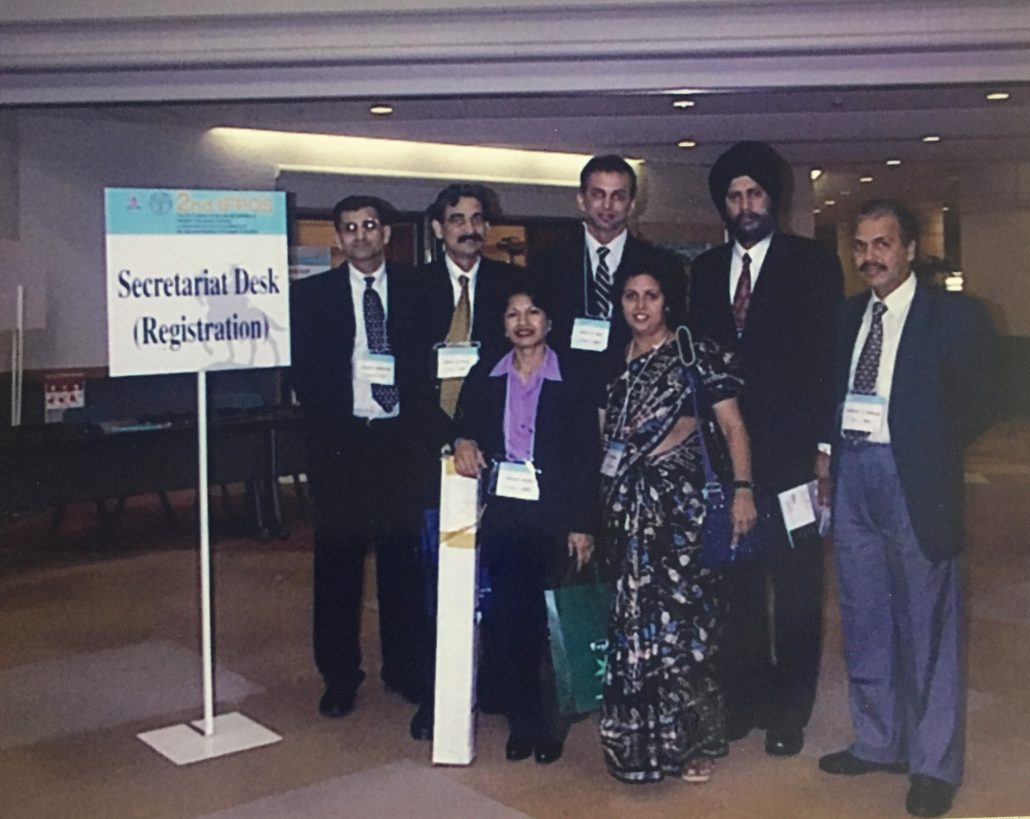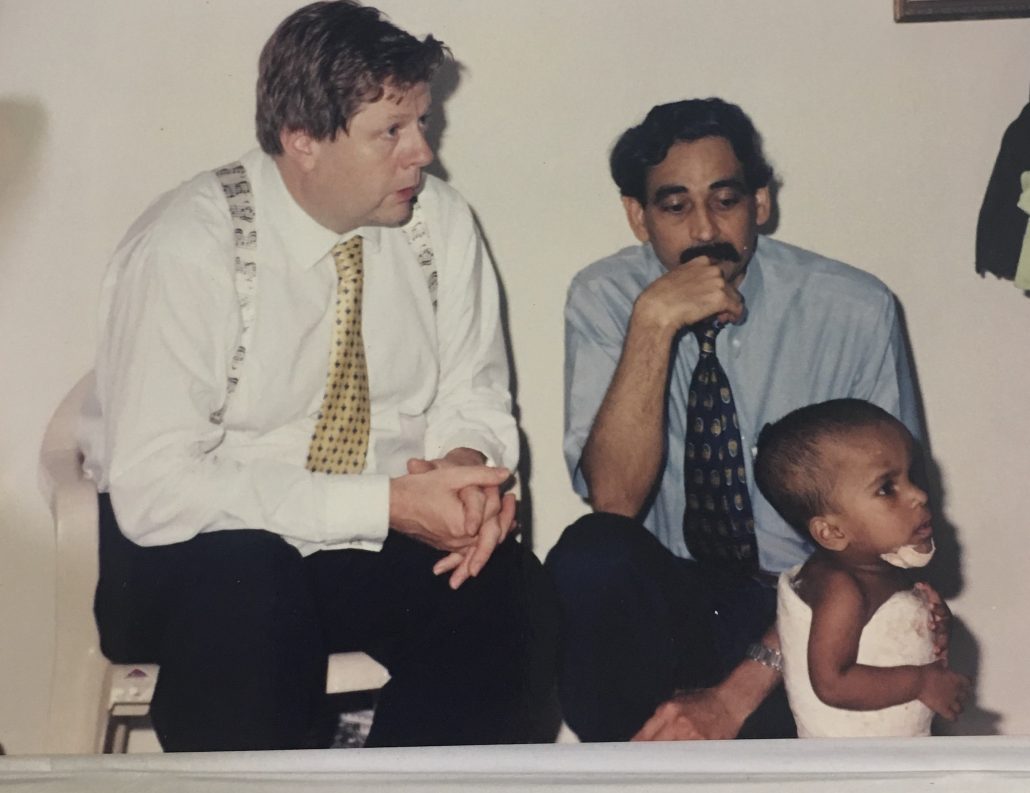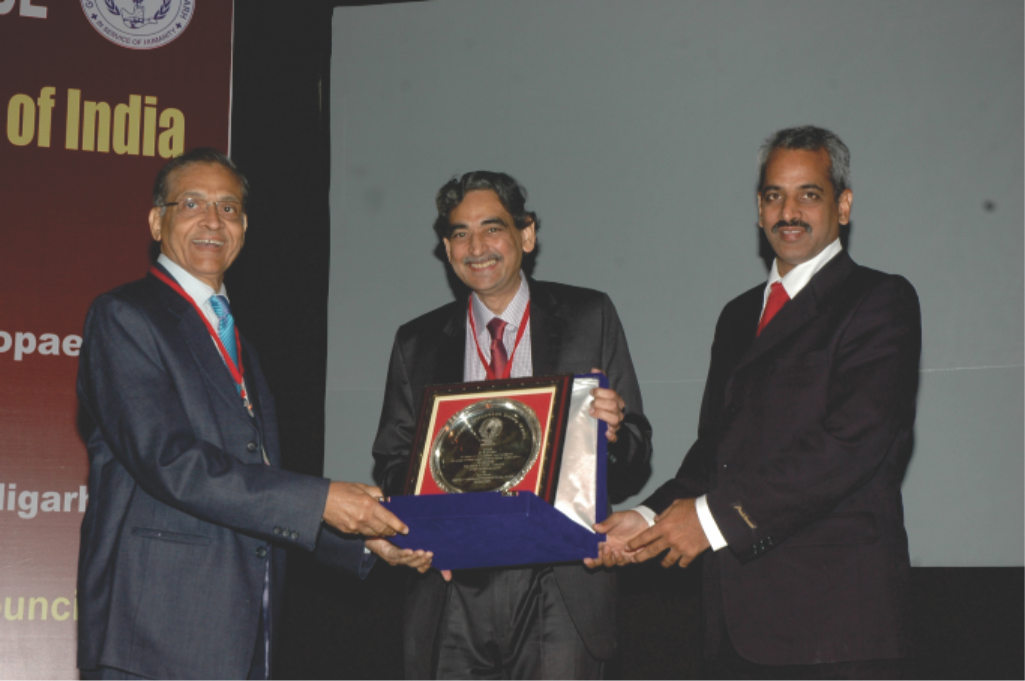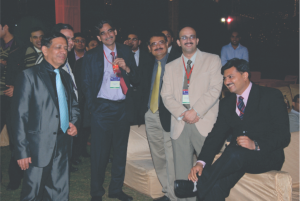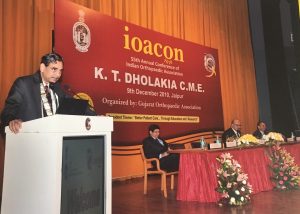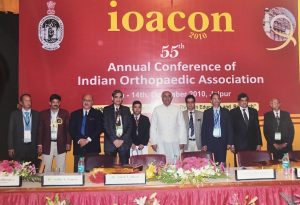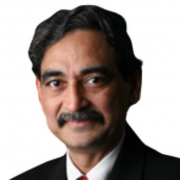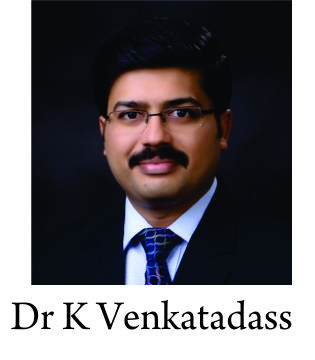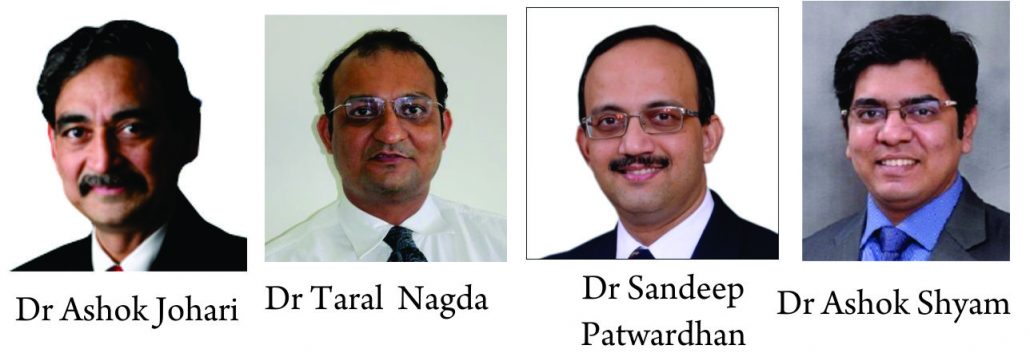Dr Benjamin Joseph – A Life Less Ordinary
Dr Benjamin Joseph – A Life Less Ordinary
Listen to advice and accept discipline, and at the end you will be counted among the wise. – Proverbs 19:20 –
This interview with Dr Benjamin Joseph (Dr Benjamin) was conducted in Hotel Le Meredian Nagpur. The interview was conducted by Dr Taral Nagda (Taral) and Dr Ashok Shyam (Ashok) on the second day of 23rd Annual Conference of Paediatric Orthopaedic Society of India. The purpose of this interview is to know more about the journey of Dr Benjamin Joseph specially as a paediatric orthopaedic surgeon. He is one of the founder member of Paediatric Orthopaedic Society of India and it is a privilege and honour for IJPO to publish his interview on the occasion of 25th Silver POSICON 2019.
Ashok: Let’s begin this interview by knowing something about your family? Dr Benjamin: I was born in 1951 in Ooty. My Initial schooling was in Ooty and then after class 6, I was in Hyderabad in a boarding school, and then I decided to do medicine in Vellore.
Taral: What inspired you to get into medicine? Dr Benjamin: My mother had some health issues, and as a kid, I told her I would cure her, probably that played on my subconscious mind. The training I got in Vellore was outstanding. One of the departments which were good was dept of Neurology, and all lectures were taken for UGs by Professors and not by juniors. After 5 in the evening when they finished their OPDs MCH students would take us to the wards and show us practically the cases. They took immense trouble to teach us. That commitment for the super specialists to teach the UGs was phenomenal. Several such departments at Vellore that inspired me.
Taral: If you weren’t a doctor what would you have been? Dr Benjamin : I really don’t know, never thought about it. Once I made up my mind, I never looked back. After finishing Medicine, I worked in a small hospital in Kerala. On the First day I got 5 patients struck with lightening. That is when I realized how inadequately we are trained. Also this hospital was seriously understaffed. The was one clinician from Miraj who was a pediatrician, Gynaecologist and Surgeon combined but he did not do orthopaedics. He would send all orthopaedic work to me and I always wanted to take up a surgical branch. I could hardly make out the murmurs and heart sound, so medical branches were not for me. I started getting all orthopaedic work and that’s how I took up orthopaedics. Later I worked as a demonstrater in the anatomy department and there I relaised the joy of explaining to students concepts that they do not understand. Making the students successfully coneptualise a difficult part is a joy for a teacher too. It is as gratifying a curing a patient from disease. That is the first time I thought that I would take up an academic position in my life. I applied for orthopaedics. Unfortunately, I was on the waiting list in Vellore. Simultaneously I applied in Madras, and I went for an interview were I was asked if I wanted to take up orthopaedics, I said a yes. Then I was asked what is the ossification of the sphenoid bone? As I was teaching anatomy and I was teaching head and neck then so I knew the answer to it. I didn’t get any appreciation for the answer, and I was asked what is the ossification of the pubic crest. It just happened that I got into Manipal and started my training with Dr Chacko. That was entirely by chance
Taral: Tell us something more about the training and about Dr Chacko Dr Benjamin: My teacher, Dr Chacko, was a very good surgeon. Very good at soft tissue handling and his techniques were perfect. He was a pretty balanced person, he could do very up to date surgeries but on the other hand was quite conservative too. He was fairly easy to work with and I was quite outspoken of which he has always been very tolerant about. I learnt a lot from him and I used to bug him with many questions. The department consisted of him and one assistant professor. So a lot of responsibility was given to us residents.
Taral: So how was orthopaedics at that time? Dr Benjamin: It was very different understandably because in that time for open fractures we used a technique called Vinitorr. Clean the wound, debride and cast it, when it smells open the cast debride it again and cast. Every Trochanteric fracture was treated by traction. We were very good at casting and traction techniques. Unfortunately a lot of good things about plastering techniques are lost. It was a pleasure listening to Shital Parikh today on wedging a cast. When I did that in New Zealand they were absolutely jaw dropping as they didn’t know about it but it is such a simple useful tool. And that’s a bit of dying art, putting a good plaster. I always use the example of indication for fixing of forearm fractures in children of which one is displaced after cast. But when you look at the cast, these are poorly put cast. If you put a decent cast, very few forearms fractures in children require fixation. As a testimony to that, my own daughter had a forearm fracture. It was closed fracture with forearm almost 90º bent and she was 6 years old. I told one of my colleagues to put in a cast and she remodeled completely. I shuddered to think that in some parts of the world clavicle fractures are fixed in children too. I am highly conservative
Taral: Tell us about your role as a Teacher of Orthopaedics? Dr Benjamin : I am a tough teacher but a liberal examiner. When I go for rounds, I want to know what that chap doesn’t know so that he can fill up the lacunae As an examiner I just make sure that the students know enough and are safe to practice. I will never fail a person unfairly. Cheating is something I don’t tolerate. I came for an exam where only 3 cases were kept as a long case while they should have kept many more and I was told that they don’t have any patients and clearly the candidate knew what the case was, there was no doubt about it. He made a diagnosis of girdle stone clinically, and one of the examiners said “bahot achcha” and patted him on his back. I took objection to that, and I said I haven’t finished examining, then asked him a couple of questions. He was unable to answer the management part. I was very unhappy with the examiners and the system. We need to change the system
Taral: If you had the power to change the exam system, what would you have done? Dr Benjamin : I would ask the student to demonstrate tests and ask about the rationale. I would take off all the meaningless things in the system. I would revamp the system completely but those are things beyond me.
Taral: How was your MS Exam? Dr Benjamin : I finished my MS exam in Manipal; it was very exhaustive. I never got my institute as my centre both in MBBS or MS. I had to go to Mangalore for my exam. We had two very nice examiners. I cleared my exam with distinction, took up a job at the mission hospital, got back into teaching, applied to St. Johns medical hospital. St. John had this policy of writing to the dean of the parent institute to send a recommendation. Manipal dean wrote them a letter but also send 3 letters asking me to come back; Dean was from my wife’s department. He knew I did well for my exam and wanted me back at Manipal. One incident about Theory paper I remember which was quite interesting. I paper 1 we had a question of anatomy and clinical Ligamentous injuries of the knee. In 1976, Jack Hughston wrote his seminal paper on the instability of the knee. That was when we started this Lachmann test, before that it was only drawers test and medial lateral stress test. I wrote that entire concept at great length in my paper. In the last paper there was another full question on Internal derangement of the Knee. I wrote about the collateral and orthe injuries and then I wrote that regarding the ligamentous injuries of the knee, please refere to answer of the first question in paper 1. I could get myself to write it again and I was scared that that there may be a disparity. I was scared that they will think I was too cocky [chuckles] but they were very nice. The dean still mentions it, he is 90 years now but remembers these incidences.
Ashok: You used to read journals primarily even as a resident? Dr Benjamin : Yes, I used to read journals even as a resident; there were two reasons 1. none of our textbooks, unfortunately, were revised for the last 10 years. So we had to read journals to stay updated. 2. I never had any medical textbook ever. I used to be in the library. I used to read a lot of journals and that practice has stayed with me all my life.
Taral: Did you always want to settle down in Manipal? Dr Benjamin: I like smaller places. Born and brought up in Ooty, been in Hyderabad, Vellore, so it didn’t matter to me where I was. In 1985 I took up Pediatric Orthopaedics as a Subspeciality. Initially, there was a lot of resistance shown and I wrote down all the suggestions and plans and got it started
Taral: Why Pediatric Orthopaedics? Dr Benjamin : I like kids in general from the beginning, and my thesis was on clubfoot. I still love kids. The other area I was interested in was had, but my love for kids won. It wasn’t difficult for me to make a choice and very honestly financial issues never influenced my decisions. I never thought too far ahead or had , my planning is more on day to day. I kept applying for more posts and I had a pink file which I recently destroyed, it said applications and rejects. Those days there was no mails, so we used to write formal letters. So the file got thicker and thicker. And I kept it with me to show my residents that don’t worry at all this is what happens with everyone. It is part of life.
Taral: How was your training in the UK? Dr Benjamin : I was Dr. W. J. W. Sharrard’s last fellow before he retired. He was a very fatherly figure and a very nice and pargamtic man. He had tremors, so later he stopped scrubbing in cases but would guide us from outside. His book of Paediatric orthopaedics and Fractures is an excellent book. Incidentally when I went to Sheffield, I got a copy of the book signed by him. It was my first medical textbook that I owned (7 years after my MS). It was a very nice time with him. There was Dr John Taylor whom Ashok [Johari] mentions in his interview and he was an amazing person. I went a year before Ashok Johari and I met him there in the UK. I came back in 1988 and in 1989 I got my unit in Manipal.
Ashok: You have been in the pioneer in developing Pediatric Orthopaedics in India? Do share us the story from the beginning Dr Benjamin : It was quite clear that this subspecialty should develop in a young country like India. My fellowship was funded by Smith and nephew in 1985, and I wrote to them that I wanted to develop pediatric orthopaedics in India. By being in a teaching institute, I could induce this subject in others and influence others to take up this subject. We started fellowship programmes and whatever I wrote on paper became true. This was in 1985 and 10 years later in 1995 we had the first meeting of POSI in Manipal. So it is wonderful to dream about something and then work to make it a reality. Initially, it was just Dr.Ashok Johari and me, but we later decided to have more seniors involved. Ashok spoke to Dr Taraporewala and I spoke to Dr Chacko. We also involved Dr Sriram and five of us formed the steering committee. And we continued with Dr Chacko as president, Dr Taraporewala was Vice president with Dr Ashok as the secretary and me and Dr Sriram were as the board members
A Did you face any resistance? shok: Dr Benjamin: Not really. We laid down some strict criteria initially to become a member, so we changed and relaxed the criteria. We retained the entry into executive committee member
Ashok: You were the one who designed the Log of POSI. Please tell us the story behind the logo? Dr Benjamin : I like art; I like drawing, so it was not difficult. In 1988 WHO was trying to eradicate Polio. Emphasis was on girl child that time. So in front of the logo, you see a girl with a hand to knee gait. The Nocholas Andry tree is held by No 1 which implicates that first, we want to eradicate Polio. Color blue-I like the colour blue, so I chose blue. In the backdrop is Ashok Chakra saying that it is an Indian Society.
Ashok: What are the important landmarks of POSI? Dr Benjamin : It is not so much as landmarks, but over time to time the the quality of meetings has improved. It has gone from strength to strength. Over all It’s a vibrant society. In some of the larger societies people are more concerned about positions but that is not the case with POSI. It is a nice trend and emphasis is always on the scientific sessions. Fun and food are all secondary. A lot of foreign faculties are coming now, so it is very important that we maintain the standards. We should be able to teach them also and it is our responsibility too. A lot of what we do is new and it is new to them too. I feel proud that we had built up something and nurtured it. We have done our part and others can take it ahead.
Ashok: Advise for POSI as an organization? Dr Benjamin : It should remain one of the best societies. Set high standards
Ashok: Research and Publications- how difficult or easy it was? Dr Benjamin : I was convinced that we should share our experiences and knowledge in our scientific communication. Initially, it was tough once you learn it becomes easy. It’s not easy to start but don’t give up. My first paper when I wrote, I had to revise it seven times and send to seven different journals till it finally got published in one. From then on we slowly started building on the concepts. Slowly documentation got better. I started data collection personally. Suddenly I realized that I have
B Joseph
7 International Journal of Paediatric Orthopaedics Volume 5 Issue 1 Jan-April 2019 Page 4-8 | | | | |
www.ijpoonline.com
6200 x rays of patients. They are still there and I can get back to them and analyse. It needed effort on my part, but it was possible. You need to be honest in research and I always teach all my fellows to be ruthlessly honest for every research. I set apart a dedicated time for research and I have always enjoyed the research. One of the best things is to guide a PG properly and that can lead to a good paper. He has to be honest and you have to design it well. More than 16 of my PG had
their thesis published in good journals.
Ashok: What are your views on current status of Pediatric Orthopaedics in India? Dr Benjamin : Paediatric orthopaedic in India has grown well but there is still a lot of scopes. We need more Pediatric orthopaedic surgeons and we should seriously think about it as a society. Paediatric orthopaedic should reach rural areas and underprivileged.
Ashok: What is your advice to surgeons who are starting their orthopaedic practice? Dr Benjamin : Don’t try to do the complicated things first, go slow. Take help and never be reluctant to tell a patient an honest opinion that this is beyond you and that they need a second opinion. It is not a sign of defeat, the patient will respect you for it. Send them to the right person. You must build up a practice on solemn reputation and ideally should be by word of mouth and not my websites. The strongest way of publicity is the word for mouth for our profession.
Ashok: What are your hobbies other than Orthopaedics? Dr Benjamin : I like reading and I like painting. I am not very choosy about books
Ashok: Any kind of philosophy that you follow? Dr Benjamin : I am a deeply religious person, I believe God has guided our destiny and I have no doubts about it. And I feel very content with what he has given me. I believe that opportunities are god given and I have the responsibility to give back to society too. I will like to slow down now, I have enjoyed my run thoroughly.
Ashok: What is the Mantra of Dr Benjamin Joseph? Dr Benjamin : Work Hard, nothing comes on a platter, everything has got its own demands. Play by the rules and be honest
Ashok: What would you like the Legacy of Dr Benjamin Joseph to be known as? Dr Benjamin : Somebody some years ago asked me from the point of view of pediatric orthopaedics what I wd like to be known for. At that time I answered that I would like to be known for my work on Cerebral Palsy. Although I am being known for Perthes due to my publication on Perthes. However I have treated many more CP than any other disease. That is something that I have done. If people remember my contributions, specially whom I have taught, if it has some impact on their lives, I would be happy.
| How to Cite this Article: Joseph B. Dr Benjamin Joseph – A Life Less Ordinary. International Journal of Paediatric Orthopaedics Jan-April 2019;5(1):4-8. |


